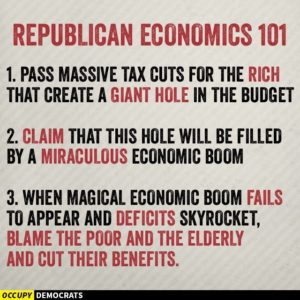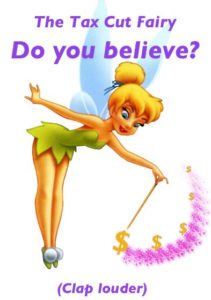The so-called “Trump rally” in the stock market is fueled by unbridled greed and giddy anticipation of a huge corporate welfare tax cut package “even as Washington remains gridlocked and evidence of any real pickup in the economy is scarce.”
The market impact of the Trump presidency is based so far on prospects — with details and congressional dynamics left to be sorted out — rather than accomplishments.
* * *
The cause for bullishness on Tuesday was Mr. Trump’s new call to cut the corporate tax rate to 15 percent, from 35 percent — deficits, perhaps, be damned.
As the Sith Lord Dick Cheney infamously reminded us, “Reagan proved that deficits don’t matter” to Republicans when they are in the White House.
The New York Times reports, Trump’s Tax Plan: Low Rate for Corporations, and for Companies Like His:
 President Trump plans to unveil a tax cut blueprint — not an actual bill — on Wednesday that would apply a vastly reduced, 15 percent business tax rate not only to corporations but also to companies that now pay taxes through the personal income tax code — from mom-and-pop businesses to his own real estate empire, according to several people briefed on the proposal.
President Trump plans to unveil a tax cut blueprint — not an actual bill — on Wednesday that would apply a vastly reduced, 15 percent business tax rate not only to corporations but also to companies that now pay taxes through the personal income tax code — from mom-and-pop businesses to his own real estate empire, according to several people briefed on the proposal.
The package would also increase the standard deduction for individuals, providing a modest cut for middle-income people and simplifying the process of filing tax returns, according to people briefed on its details. That proposal is opposed by home builders and real estate agents, who fear it would diminish the importance of the mortgage interest deduction. And it is likely to necessitate eliminating or curbing other popular deductions, a politically risky pursuit.
As of late Tuesday, the plan did not include Mr. Trump’s promised $1 trillion infrastructure program, two of the people said, and it jettisoned a House Republican proposal to impose a substantial tax on imports, known as a border adjustment tax, which would have raised billions of dollars to help offset the cost of the cuts [and to pay for Trump’s folly of a border wall.]
With that decision, Mr. Trump acceded to pressure from retailers and conservative advocacy groups, but the move could deepen the challenge of passing a broad tax overhaul in Congress, where concern about the swelling federal deficit runs high. His plan would put off the difficult part of a tax overhaul: closing loopholes and increasing other taxes to limit the impact of tax cuts on the budget deficit.
Republicans are likely to embrace the plan’s centerpiece, substantial tax reductions for businesses large and small, even as they push back against the jettisoning of their border adjustment tax. The 15 percent rate would apply both to corporations, which now pay 35 percent, and to a broad range of firms known as pass-through entities — including hedge funds, real estate concerns like Mr. Trump’s and large partnerships — that currently pay taxes at individual rates, which top off at 39.6 percent. That hews closely to the proposal Mr. Trump championed during his campaign.
But Mr. Trump’s decision to extend the corporate tax cut to real estate conglomerates like his own will give Democrats a tailor-made line of attack.
 This is Republican orthodoxy, i.e., faith based supply-side “trickle down” GOP economics which has been entirely disproved and discredited over the past 40 years. Arthur Laffer’s Theory on Tax Cuts Comes to Life Once More: “What the first President George Bush once called “voodoo economics” is back, as Mr. Trump’s advisers argue that deep cuts in corporate taxes will ultimately pay for themselves with an explosion of new business and job creation.”
This is Republican orthodoxy, i.e., faith based supply-side “trickle down” GOP economics which has been entirely disproved and discredited over the past 40 years. Arthur Laffer’s Theory on Tax Cuts Comes to Life Once More: “What the first President George Bush once called “voodoo economics” is back, as Mr. Trump’s advisers argue that deep cuts in corporate taxes will ultimately pay for themselves with an explosion of new business and job creation.”
““The tax plan will pay for itself with economic growth,” Steven Mnuchin, the Treasury secretary and main architect of the plan, told reporters this week.”
The trickle-down tax cut fairy is back. God save us.
Economist and Times pundit Paul Krugman anticipated this in a recent column. Zombies of Voodoo Economics:
Mr. Trump sold himself to voters as unorthodox as well as effective. He was going to be a different kind of president, a consummate deal-maker who would transcend the usual ideological divide. His supporters should therefore be dismayed, not just by his failure to actually close any deals, but by the fact that he evidently has no new ideas to offer, just the same old snake oil the right has been peddling for decades.
We saw that on Trumpcare, where the administration outsourced its policy to Paul Ryan, who produced exactly the kind of plan you might have expected: take insurance away from millions, make it worse for the rest, and use the money to cut taxes on the wealthy. Populism!
And now we’re seeing it on taxes. Mr. Trump has promised to unveil a “massive” tax cut plan next week. This announcement apparently came as a surprise to his own Treasury officials, who obviously don’t have a plan ready. Still, one thing is clear: Whatever the details, Trumptax will be a big exercise in fantasy economics.
How do we know this? Last week Stephen Mnuchin, the Treasury secretary, told a financial industry audience that “the plan will pay for itself with growth.” And we all know what that means.
 Back in 1980 George H. W. Bush famously described supply-side economics — the claim that cutting taxes on rich people will conjure up an economic miracle, so much so that revenues will actually rise — as “voodoo economic policy.” Yet it soon became the official doctrine of the Republican Party, and still is. That shows an impressive level of commitment. But what makes this commitment even more impressive is that it’s a doctrine that has been tested again and again — and has failed every time.
Back in 1980 George H. W. Bush famously described supply-side economics — the claim that cutting taxes on rich people will conjure up an economic miracle, so much so that revenues will actually rise — as “voodoo economic policy.” Yet it soon became the official doctrine of the Republican Party, and still is. That shows an impressive level of commitment. But what makes this commitment even more impressive is that it’s a doctrine that has been tested again and again — and has failed every time.
Yes, the U.S. economy rebounded quickly from the slump of 1979-82. But was that the result of the Reagan tax cuts, or was it, as most economists think, the result of interest rate cuts by the Federal Reserve? Bill Clinton provided a clear test, by raising taxes on the rich. Republicans predicted disaster, but instead the economy boomed, creating more jobs than under Reagan.
 Then George W. Bush cut taxes again, with the usual suspects predicting a “Bush boom”; what we actually got was lackluster growth followed by a severe financial crisis. Barack Obama reversed many of the Bush tax cuts and added new taxes to pay for Obamacare — and oversaw a far better jobs record, at least in the private sector, than his predecessor.
Then George W. Bush cut taxes again, with the usual suspects predicting a “Bush boom”; what we actually got was lackluster growth followed by a severe financial crisis. Barack Obama reversed many of the Bush tax cuts and added new taxes to pay for Obamacare — and oversaw a far better jobs record, at least in the private sector, than his predecessor.
So history offers not a shred of support for faith in the pro-growth effects of [trickle-down] tax cuts.
Oh, and let’s not forget recent experiences at the state level. Sam Brownback, governor of Kansas, slashed taxes in what he called a “real live experiment” in conservative fiscal policy. But the growth he promised never came, while a fiscal crisis did. At the same time, Jerry Brown’s California raised taxes, leading to proclamations from the right that the state was committing “economic suicide”; in fact, the state has experienced impressive employment and economic growth.
In other words, supply-side economics is a classic example of a zombie doctrine: a view that should have been killed by the evidence long ago, but just keeps shambling along, eating politicians’ brains. Why, then, does it persist? Because it offers a rationale for lower taxes on the wealthy — and as Upton Sinclair noted long ago, it’s difficult to get a man to understand something when his salary depends on his not understanding it.
Still, Donald Trump was supposed to be different. Guess what: he isn’t.
To be fair, it’s not clear whether Mr. Trump really believes in right-wing economic orthodoxy. He may just be looking for something, anything, he can call a win — and it’s a lot easier to come up with a tax reform plan if you don’t try to make things add up, if you just assume that extra growth and the revenue it brings will materialize out of thin air.
We might also note that a man who insists that he won the popular vote he lost, who insists that crime is at a record high when it’s at a record low, doesn’t need a fancy doctrine to claim that his budget adds up when it doesn’t.
Still, the fact is that the Trump agenda so far is absolutely indistinguishable from what one might have expected from, say, Ted Cruz. It’s just voodoo with extra bad math. Was that what his supporters expected?
This is the next betrayal of his “populist” supporters after Trump packed his Cabinet with the wolves of Wall Street. Suckers!
Discover more from Blog for Arizona
Subscribe to get the latest posts sent to your email.

Entirely disproved? Only in the artificial reality created in research journals and in your mind.
Let’s go over the facts. Growth in work in the USA since President Reagan’s tax rate reductions began: 87 billion hours
Growth in work in France: negative 3 billion hours.
Relative growth to the European Union: In 1980, the European Union countries GDP was 30% higher than USA, today? 20% lower.
England rich taxpayers (above 1,000,000 pounds sterling, 1.25 M$) 1.9 for every 1000 citizens paying 4% of their personal income taxpayers. USA? 11 per 1000 citizens paying 19% of our personal income taxes.
Exactly as supply siders predicted, exactly as Andrew Mellon predicted in the roaring 20’s with his “scientific taxation.” The rich pay a higher share of the burden when subject to lower rates.
In 1980, the top 1% had a taxable income of $80,000. Adjusted for inflation, that would be about $240,000 today. They went from paying $47 billion and 19% of all personal income taxes to paying $470 billion and 56% of all personal income taxes today. Adjusted for inflation, they went from $150 billion to an eyepopping $470 billion. Lower tax rate, much greater revenues.
The revenue maximizing tax rate is somewhere below 20%. That would be a problem for this blog wouldn’t it? No one would need tax lawyers or tax accountants anymore.
World bank, Stlouis fed reserve, OECD websites.